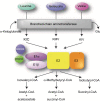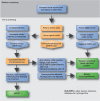Maple syrup urine disease: mechanisms and management
- PMID: 28919799
- PMCID: PMC5593394
- DOI: 10.2147/TACG.S125962
Maple syrup urine disease: mechanisms and management
Abstract
Maple syrup urine disease (MSUD) is an inborn error of metabolism caused by defects in the branched-chain α-ketoacid dehydrogenase complex, which results in elevations of the branched-chain amino acids (BCAAs) in plasma, α-ketoacids in urine, and production of the pathognomonic disease marker, alloisoleucine. The disorder varies in severity and the clinical spectrum is quite broad with five recognized clinical variants that have no known association with genotype. The classic presentation occurs in the neonatal period with developmental delay, failure to thrive, feeding difficulties, and maple syrup odor in the cerumen and urine, and can lead to irreversible neurological complications, including stereotypical movements, metabolic decompensation, and death if left untreated. Treatment consists of dietary restriction of BCAAs and close metabolic monitoring. Clinical outcomes are generally good in patients where treatment is initiated early. Newborn screening for MSUD is now commonplace in the United States and is included on the Recommended Uniform Screening Panel (RUSP). We review this disorder including its presentation, screening and clinical diagnosis, treatment, and other relevant aspects pertaining to the care of patients.
Keywords: BCKDHA; BCKDHB; DBT; alloisoleucine; branched-chain amino acids; maple syrup urine disease; newborn screening.
Conflict of interest statement
Disclosure The authors report no conflicts of interest in this work.
Figures


Similar articles
-
Clues and challenges in the diagnosis of intermittent maple syrup urine disease.Eur J Med Genet. 2020 Jun;63(6):103901. doi: 10.1016/j.ejmg.2020.103901. Epub 2020 Mar 6. Eur J Med Genet. 2020. PMID: 32151765
-
Eleven novel mutations of the BCKDHA, BCKDHB and DBT genes associated with maple syrup urine disease in the Chinese population: Report on eight cases.Eur J Med Genet. 2015 Nov;58(11):617-23. doi: 10.1016/j.ejmg.2015.10.002. Epub 2015 Oct 8. Eur J Med Genet. 2015. PMID: 26453840
-
Exploring molecular spectrum in thai patients with maple syrup urine disease: unveiling a common variant.Orphanet J Rare Dis. 2024 Oct 25;19(1):396. doi: 10.1186/s13023-024-03411-7. Orphanet J Rare Dis. 2024. PMID: 39456016 Free PMC article.
-
Brain Branched-Chain Amino Acids in Maple Syrup Urine Disease: Implications for Neurological Disorders.Int J Mol Sci. 2020 Oct 11;21(20):7490. doi: 10.3390/ijms21207490. Int J Mol Sci. 2020. PMID: 33050626 Free PMC article. Review.
-
Neonatal maple syrup urine disease in China: two novel mutations in the BCKDHB gene and literature review.J Pediatr Endocrinol Metab. 2021 Jun 30;34(9):1147-1156. doi: 10.1515/jpem-2020-0746. Print 2021 Sep 27. J Pediatr Endocrinol Metab. 2021. PMID: 34187135 Review.
Cited by
-
Metabolic adaptations to hypoxia in the neonatal mouse forebrain can occur independently of the transporters SLC7A5 and SLC3A2.Sci Rep. 2021 Apr 27;11(1):9092. doi: 10.1038/s41598-021-88757-9. Sci Rep. 2021. PMID: 33907288 Free PMC article.
-
Branched-chain amino acids in cardiovascular disease.Nat Rev Cardiol. 2023 Feb;20(2):77-89. doi: 10.1038/s41569-022-00760-3. Epub 2022 Sep 5. Nat Rev Cardiol. 2023. PMID: 36064969 Free PMC article. Review.
-
Mitochondrial Alpha-Keto Acid Dehydrogenase Complexes: Recent Developments on Structure and Function in Health and Disease.Subcell Biochem. 2024;104:295-381. doi: 10.1007/978-3-031-58843-3_13. Subcell Biochem. 2024. PMID: 38963492 Review.
-
Recent Progress on Branched-Chain Amino Acids in Obesity, Diabetes, and Beyond.Endocrinol Metab (Seoul). 2019 Sep;34(3):234-246. doi: 10.3803/EnM.2019.34.3.234. Endocrinol Metab (Seoul). 2019. PMID: 31565875 Free PMC article. Review.
-
Characteristics of continuous venovenous hemodiafiltration in the acute treatment of inherited metabolic disorders.Pediatr Nephrol. 2022 Jun;37(6):1387-1397. doi: 10.1007/s00467-021-05329-9. Epub 2021 Oct 25. Pediatr Nephrol. 2022. PMID: 34693482 Free PMC article.
References
-
- Yudkoff M, Daikhin Y, Nissim I, Horyn O, Luhovyy B, Lazarow A. Brain amino acid requirements and toxicity: the example of leucine. J Nutr. 2005;135(6 Suppl):1531S–1538S. - PubMed
Publication types
LinkOut - more resources
Full Text Sources
Other Literature Sources

